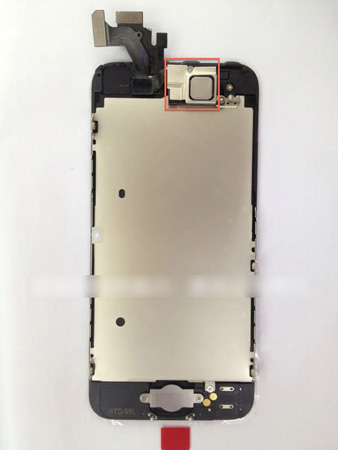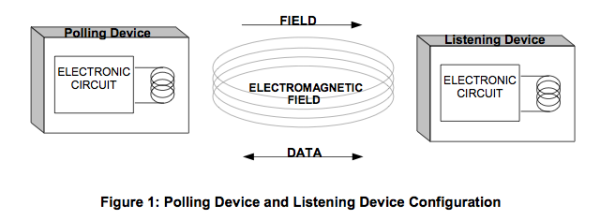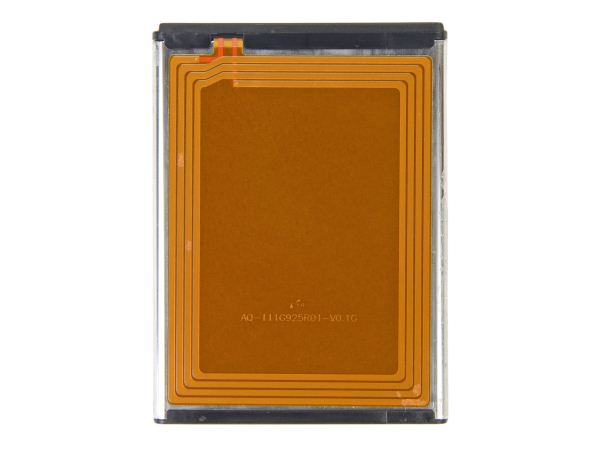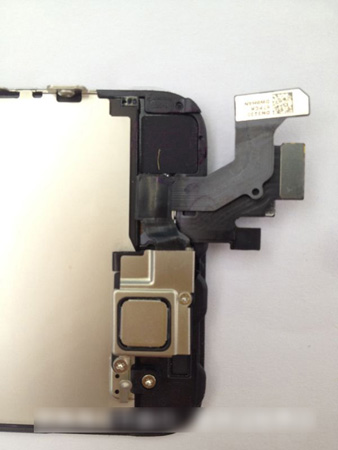Preparing for the iPhone Next: Rumors Analyzed
by Brian Klug & Anand Lal Shimpi on August 27, 2012 9:40 PM EST- Posted in
- Smartphones
- Apple
- Mobile
- iPhone
NFC, Unlikely
The most recent rumor is that this mysterious square chip (occluded by an EMI can) is an NFC combo controller and antenna, based purely on its square dimensions.

The NFC "chip" ensquared in red
Given the primarily metal backside of the new iPhone, it's highly unlikely that NFC is in the cards for this generation. In fact, given the very little space at top and bottom dedicated to those glass RF windows, you can almost entirely rule it out.
NFC operates on the 13.56MHz ISM band, which has a relatively large wavelength, at 22.1 m. Making a traditional dipole antenna that radiates at all given the constraints of a smartphone package is thus a big challenge, considering that smartphones are maybe 5-inches tall at maximum, to say nothing of the supposed upcoming iPhone's longest linear dimension.

From the NFC Forum Analog Specification
As a result almost all NFC antennas are big inductors and work using a magnetic field coupled between a host and peer device. Since we're talking about an inductor, NFC antennas use as big of a coil of wire as possible with as many wires as possible tightly wound together, and thus often use as big of an unbroken 2D plane as they can get on the device. In the smartphone space, basically all NFC antennas to date are simply flat spirals on a PCB. Whether this gets hidden on top of the battery like what Samsung has done in recent devices, or printed on the back battery cover like earlier devices, the antenna is ultimately a big square or circle with as big and dense of a coil as possible.

Galaxy Nexus Battery and NFC Antenna Coils (Courtesy iFixit)
Getting a good inductor into the device is important because how much inductance your antenna has will determine maximum coupling distance and ease of alignment. It shouldn't need saying, but having a huge ground plane (the unibody metal back case) in the way of your NFC antenna will seriously degrade performance, thus only the top or bottom windows are logical places to put it.
It's this last point which makes us very skeptical about the top or bottom RF windows being used for a relatively small NFC loop – not because such a thing is impossible – but rather because of how terrible the resulting ease of alignment and maximum coupling distance would be. Most NFC implementations at present place the inductive coils as near to the center of the device as possible, partly because this is the most optimal way to maximize the area which can be dedicated to it, partly because it makes alignment natural. With an NFC antenna at the extreme top or bottom, alignment with non-iPhones (for example, payment tokens or reader tags) becomes a much more confusing task, and that doesn't seem like the Apple-like level of polish everyone is waiting for to drive NFC adoption.

There's also a healthy number of signaling pins in the flex cable leaving the mystery chip, some of which appear to be signaling for the front facing camera which is part of the assembly, others for earpiece, proximity, and ambient light sensor. In addition this assembly also is obviously the assembled display and touch stack. When you consider the inclusion of in-cell touch sensing which has been rumored for the upcoming iPhone, and the requirement for time multiplexing of both display driving and touch sensing signals (to mitigate interference and make this possible), it's more likely that the components under that heavily shielded (and grounded with a big spring finger) EMI can are the touch and display controller combo that need to work in conjunction for in-cell to be possible.
The inclusion of Passbook in iOS 6 is the most often-cited piece of evidence for Apple including NFC, which seems a bit paradoxical since Apple hasn't disclosed at all whether it would favor NFC or a Bluetooth LE (low-energy) or even QR code based payment token through that gateway.










131 Comments
View All Comments
alxx - Tuesday, August 28, 2012 - link
but do ordinary consumers really care about whats under the hood(unlike us) ?A phone that works and with good battery life.
And whats on special at the carriers with a decent plan wins over the phone choice most of the time.
swb311 - Tuesday, August 28, 2012 - link
False, iOS is a thrifty OS that uses resources far better and efficiently than an off-the-shelf component thanks to Apple's custom designed silicon. So it may not look the same on paper, but the processor will feel just as fast. No one needs a quad core phone yet (apps are not prepared) so why take the battery hit? I'd rather have an upclocked dual core honestly.KoolAidMan1 - Tuesday, August 28, 2012 - link
"The iPhone is the new dumbphone"Considering that the iOS app selection is the best and largest of any mobile ecosystem, I'd say no, pretty much the opposite
KoolAidMan1 - Tuesday, August 28, 2012 - link
"they mgiht go for dual A9 (they certainly won't go quad) but that's so far behind the top phones"Even most PC applications don't use quad-cores, forget smartphones. No smartphone multitasks applications enough where quads would really matter. We're a few years away from where quad core SoCs are needed in cellphones. Until then it is marketing for neckbeards who look at spec pages without regard to practical usage scenarios or performance.
iampivot - Monday, August 27, 2012 - link
What about a fingerprint scanner?It seems obvious that one could be included in the home button, which would facilitate instantaneous verification of the user when doing NFC purchases.
8steve8 - Tuesday, August 28, 2012 - link
no a15?A5 - Tuesday, August 28, 2012 - link
Won't be ready and it wouldn't fit Apple's supply chain model to take a risk like that on the CPU. The article lays out the reasoning pretty clearly.iwod - Tuesday, August 28, 2012 - link
Not a faster SoC really annoys me, Krait from Qualcomm and Tegra etc... Quad Core ARM A9,a simple die shrinks? Or may be they bump the Frequency to 1.5Ghz or higher?
Dekker - Tuesday, August 28, 2012 - link
Even in the PC world the benefit of quad core is limited for many types of usage (email, web and office hardly benefit at all). I'm not convinced that absent a proper multitasking model in Android/iOS there is much benefit to going quad core (particularly if it reduces battery life). At this stage a slightly faster clock or more memory seems to be a more viable approach.iwod - Tuesday, August 28, 2012 - link
On PC we have Dual Thread from Single Core which accounts for 4 Threads with Dual Core. Mobile Dual Core we are still stuck at 2 threads. For the usage on mobile 4 threads will properly bring less benefits then on Desktop, but still large enough to warrant it. Having more then 2 threads for running the OS and Apps would help. Although we may wait big.LITTLE for that. Dual Core Cortex A7 + Dual Core Cortex A15.The Samsung GS3 has 4 Core 1.4Ghz SoC, I will have to see how Apple will pull its marketing and convince me to buy a Phone that is MUCH less powerful, and possibly even more expensive.